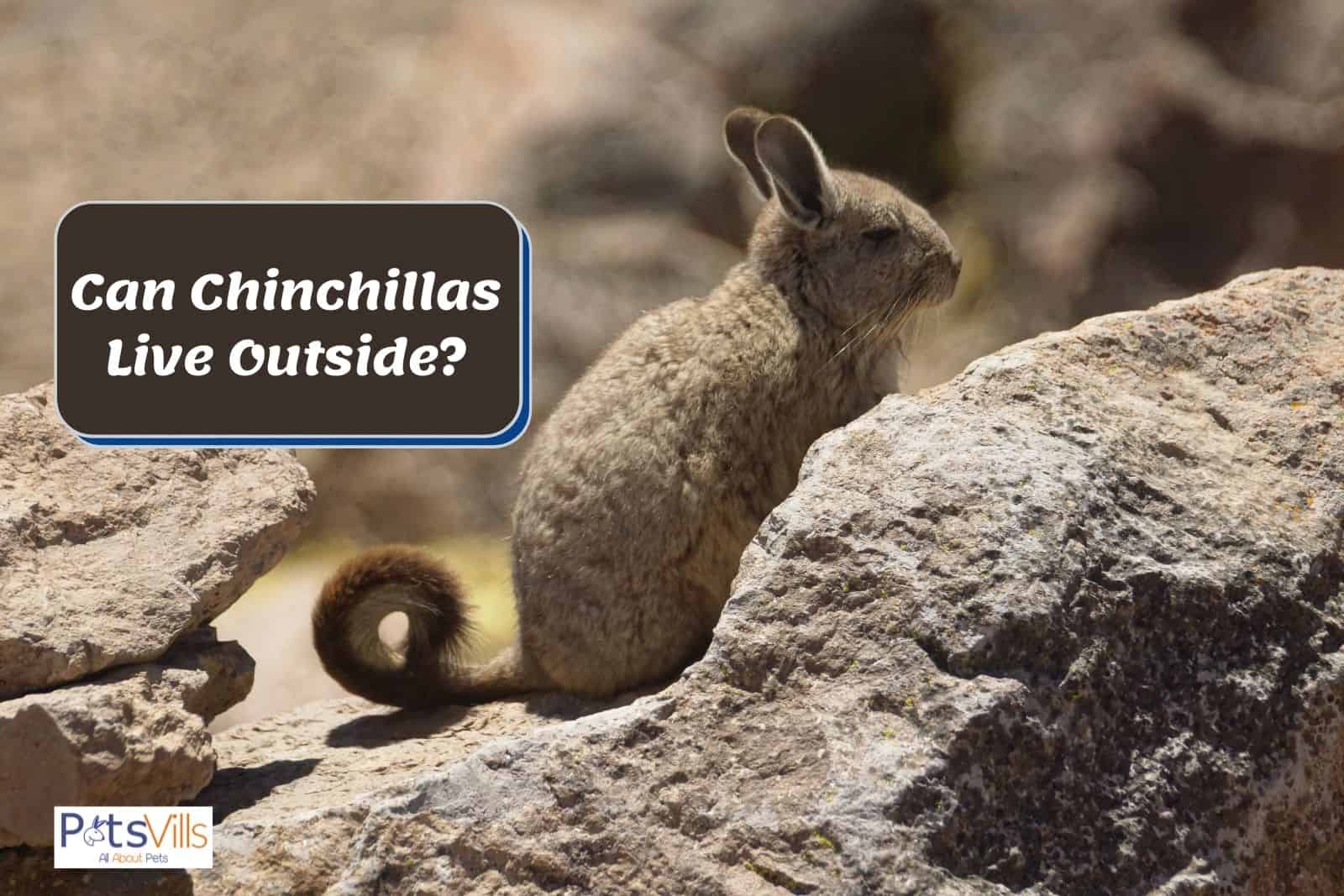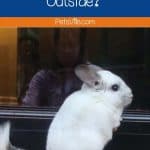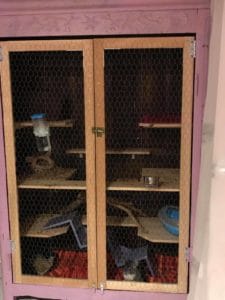Chinchillas originate from the Andes mountains areas in South America.
Can chinchillas live outside? Pet chinchillas must be kept inside the house as they can’t withstand low or high temperatures. When exposed to low or hot temperatures, chinchilla can develop health problems.
Although chinchillas have thick fur coats, they shouldn’t be kept outside. Chinchillas don’t have sweat glands like humans; therefore, they can’t cool themselves down as fast in hotter temperatures.
READ MORE: Are Chinchillas Social Animals?
Table of Contents
Can Chinchilla Live Outside?
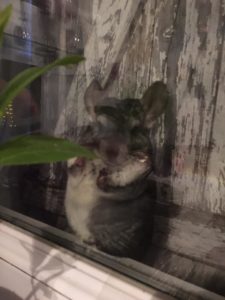 Pet chinchillas can’t withstand low or high temperatures [1].
Pet chinchillas can’t withstand low or high temperatures [1].
Chinchillas often develop respiratory infections, which may progress to pneumonia and even death, due to extended exposure to temperatures below 50 °F.
If you lack a warm place during the cold months, you can invest in a safe heat source for your chinchillas.
You can place a standard utility lamp (the kind designed to have an aluminum bowl surrounding the bulb) precisely above the pet’s cage.
Ensure that you keep the lamp cord away from the top and sides of the cage, as chinchillas will chew on anything soft.
You don’t want to electrocute your chinchilla.
Choose a light bulb that will warm the area to around 55 °F to 65 °F.
Always have a thermometer in hand to check the temperature.
To sufficiently warm a cage height of 18 inches, a bulb with 40 – 75 watts is okay.
The bulb wattage depends on the distance to the chinchillas and the room temperature.
Placing towels around the cage can help to prevent heat loss.
However, always be cautious with placing towels to avoid fire hazards. It would be best to be wary of your chinchillas as they may also start chewing on the towels.
It’s essential to make sure the living conditions don’t get too hot.
It is best to keep the chinchilla inside to control the temperatures.
Make sure to also read our guide about chinchilla life expectancy.
Can Chinchillas Live Outside in a Shed?
It is never an excellent option to keep your chinchillas outside in a shed [2].
Chinchillas require a regulated temperature environment. The only way you can keep your pets in the shed is if you are willing to give the shed an upgrade.
It is an expensive fit since the shed will require double insulation and dehumidifiers.
Most sheds are cold and gusty. Such conditions can have adverse effects on your chinchillas.
The ideal temperature should be around 64 °F to 70 °F (18 °C – 21 °C), and not any hotter. The air inside the shed should also have no moisture, which is hard to accomplish in such an environment.
Moisture makes their fur cultivate fungus.
Always keep your chinchillas inside, and their health with thrive. Chinchillas are suited for staying indoors, enabling you to have them in a temperature-regulated setting.
Can Chinchillas Live Outside in a Hutch?
If you do proper research on accommodating chinchillas, you will find out that;
- A hutch is too small for a chinchilla. Chinchillas require large and tall cages that have many different levels and floors.
- Chinchillas need to remain indoors in a controlled temperature setting.
- Chinchillas should not be exposed to direct breezes as these may lead to lung infections.
- There are wild animals outside the home, a risk to your chinchillas.
Before getting a chinchilla, make sure that you can provide the care it deserves. Chinchillas require a perfect loving home.
What Temperature Can Chinchillas Live In?
Chinchillas do not cope well with high heat or humidity as they originate from mountainous regions with cold and dry climates.
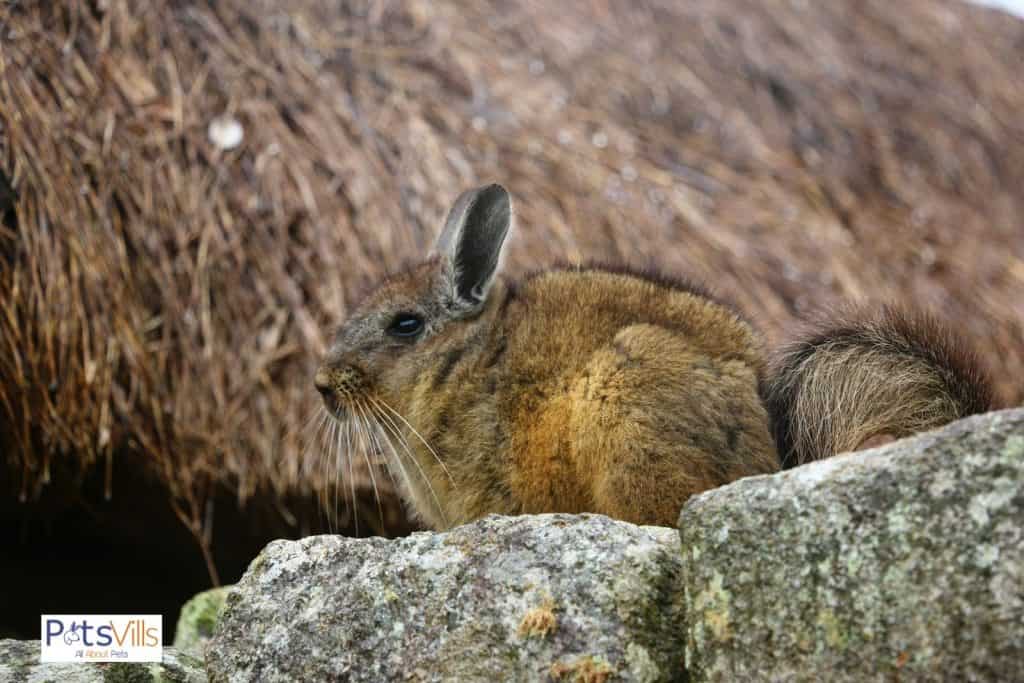
Chinchillas prefer lower temperatures, as they can generally be more active without overheating.
The native environment of chinchillas is a cool and arid region, with a constant temperature of about 50 °F to 55 °F.
Temperatures higher than 80 °F will stress out your chinchillas. The suitable temperature to keep your chinchilla in should be from 60 °F to 70 °F, and a humidity level of 40% to 60%.
Chinchillas cannot cool down quickly as they do not sweat (they don’t have sweat glands); hence they are prone to heatstroke. Before starting hot weather, make sure you can cool the room temperate down if it gets too hot.
Place the cage away from direct sunlight, which can cause overheating. There are various ways to keep your chinchilla cool, with the most effective being the use of air conditioning.
You can also use cold stone slabs to keep your chinchilla cool.
Healthy chinchillas can deal with about 80 – 88 °F (26.6 °C – 31 °C). However, the recommended level is 22 °C (71.6 °F). Older and younger chinchillas are more likely to suffer in lower temperatures.
Take a look at this video to have additional information about the right temp for chins.
Do Chinchillas Have to Live In a Cage?
Chinchillas should be kept in a large cage. Chinchillas tend to chew objects; therefore, letting them roam around your house isn’t advisory.
Minimum Cage Size
According to the Veterinary Center for Birds and Exotics, the minimum size for an adult chinchilla’s cage should measure 3 feet by 2 feet by 2 feet.
Chinchillas are social animals and prefer not to be alone in a cage.
If you choose to keep more than one chin, at least 2 square feet of floor space per chinchilla should be available.
Wire-bottomed cages should have plywood or other flat, solid elements on the cage’s floor. Chinchillas may develop pressure sores on their feet if they spend much time standing on the wire.
What’s The Ideal Environment For Chinchillas?
Chinchillas do not like loud noises or too much movement.
Chinchillas can frighten easily. You should keep your chinchillas away from young children and other pets.

Even though chinchillas can live in a cage, you should let them out each day for an hour to two hours.
The opportunity enables the chinchillas to explore the house and get a kick at exercising differently than just at the wheel in their cages.
The ideal place for the cage is in a corner or against a wall to give your chinchilla a sense of security and safety.
Although it isn’t mandatory, giving your chinchilla an exercise wheel is a good idea.
Make sure you get solid wheels to avoid the chinchilla’s feet from slipping through the bars.
You don’t want to get a metal bar wheel. A wheel with a solid surface is recommended. Chinchillas have been known to get their feet stuck in the metal bars.
They originally come from the Andes. Chinchillas are accustomed to cooler conditions. Chinchillas can die from exposure to high temperatures as they do not sweat and cannot cool themselves down.
Chinchillas love to chew on things, including baseboards, doors, and wires.
You should protect these areas and cover them up away from your chinchilla if you believe they are a threat or don’t want them to be chewed.
Being crepuscular, ensure that you keep your chinchillas in a setting where they can sleep during the day. It is unnecessary to keep them in the dark; they use daylight to determine the time to rest and when to wake up.
Nest Boxes: A Place to Hide and Rest
In the wild, chinchillas play the role of being prey to other animals. This situation leads them to have plenty of hiding places to feel safe and secure.
Ensure that your pet chinchilla has a place to hide, or you risk having them feeling stressed.
The right nest box provides a chinchilla with a hideout whenever it feels frightening. There should be a nest box for every chinchilla you have.
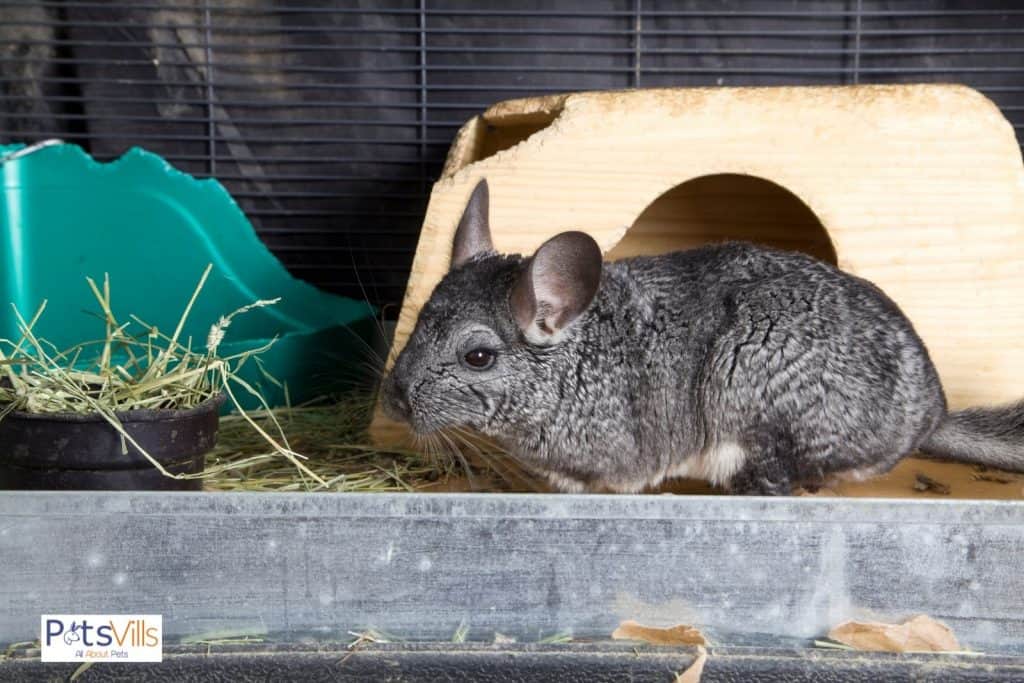
It is also advisable to provide a large nest box for the chinchillas to curl up and hide together whenever they need to.
An extra nest box should be around to give your chinchillas plenty of choices.
Ideal nest boxes should:
- Measure about 25cm by 25cm by 25cm, and be in a quiet and secluded place.
- Be lined with clean, dry bedding, such as hay, recycled wood pulp, shredded paper, or cardboard litter.
- Have dust-free bedding. Shredded newspaper is not ideal as the ink can be toxic to your chinchillas.
A Safe Enclosure
Ensure that any enclosure you use for your chinchillas is indestructible, as these rodents love to chew on things.
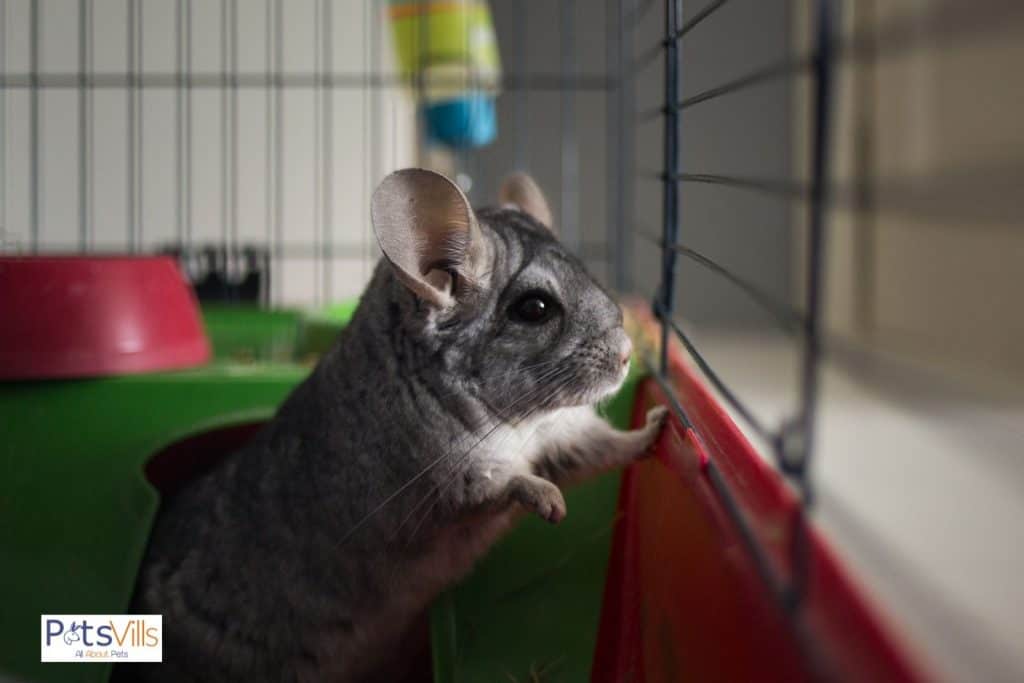
An ideal cage should be made of wire, which is durable and easy to clean.
When using a wire enclosure, provide a substantial floor space for your chinchillas to stand on.
Standing too long on the bare wire may lead to pododermatitis, a condition of swollen feet and sores on the rodent’s paws.
What is The Best Spot in Your Home For Chinchillas?
Chinchillas can get stressed and frightened by various strange sounds, smells, and sights.
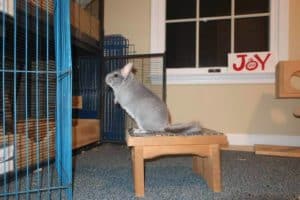
To ensure that your pets live stress-free, place their enclosure in a calm and quiet spot around the home.
The enclosure should have the right temperature of around 50 – 59 °F, and be away from direct sunlight and draughts.
Chinchillas have thick coats which can become too hot, and temperatures above 86 °F can kill them.
The cage should be in a spot not close to a noisy or busy area. Avoid TV noises and vibrations, which can cause stress to your chinchilla.
How To Keep Your Chinchilla Home Clean
As a chinchilla owner, ensure that you clean out their cages and nest boxes regularly to maintain hygiene and safety.
Take a look at the video for some cage cleaning tips.
The best time to clean is during the evening when the chinchillas as active. There is no need to wake them up in the morning for cleaning.
Chinchillas prefer an environment with their smells [3], so cleaning their cages may stress them.
To counter this, use an unscented pet-safe cleaner for the enclosure, and remember to retain little-used bedding which is still clean. This will provide a familiar smell for your chinchillas when they return to the cage.
Daily procedures include removing any dirty and wet bedding and clearing out uneaten fresh food. You need to also clean the containers before refilling them with food and water.
Every week, you should remove any dirty bedding, replace bedding on the cage’s floor, and dust all platforms and levels in the enclosure.
FAQs
Can chinchillas live in the cold?
Chinchillas can live in high altitudes of about 9,800 feet to 16,400 feet in their natural habitat. Such elevations tend to be very cold with an average minimum temperature of 23 °F. The thick fur covering their bodies works well to conserve heat.
Are chinchillas good house pets?
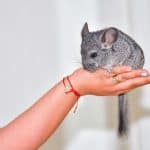
Chinchillas are great pets. They are very hygienic and will sleep during your work time. Keep in mind that chinchillas are crepuscular and not nocturnal, so don’t keep them in your room at night!
How cold can chinchillas tolerate?
Chinchillas can stand the cold much more than the heat, temperatures over 70°F, and chinchillas will start getting very stressed. An ideal temperature for a chinchilla is between 60°F to 70°F.

Can chinchillas live outside? Please share your opinion below!
Resources
- 1. Chinchilla – an overview | ScienceDirect Topics [Internet]. www.sciencedirect.com. Available from: https://www.sciencedirect.com/topics/pharmacology-toxicology-and-pharmaceutical-science/chinchilla
- 2. Chinchillas: Very Furry Rodents That Can Make Great Pets, Expert Says [Internet]. Texas A&M Today. 2007 [cited 2022 Feb 12]. Available from: https://today.tamu.edu/2007/03/13/chinchillas-very-furry-rodents-that-can-make-great-pets-expert-says/
- 3. Environment – Chinchillas – Our pets [Internet]. www.rspca.org.uk. Available from: https://www.rspca.org.uk/adviceandwelfare/pets/rodents/chinchillas/environment
Barry Stingmore is a British content writer living in Fuerteventura, Spain. An animal lover at heart, he shares his home with a dog and four rescue cats and has a passion for writing about animals big and small.
Barry loves finding answers to your animal-related questions, the more research involved the better! You can rely on him to find the facts.
Find him on FACEBOOK, TWITTER AND Linkedin
Read his latest ARTICLES.
Find more about him HERE.

